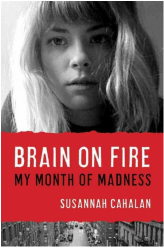Author(s) Susannah Cahalan
ISBN: 13:978-1451621389
APA Style Citation
Cahalan, S. (2012). Brain on Fire: My Month of Madness. New York: Simon and Schuster.
| openyourclassbrainonfire3.pdf |
Susannah Cahalan chronicles her journey from a successful young reporter at the New York Post to a paranoid, seemingly psychotic patient at NYU medical center only a few weeks later. Susannah experienced numbness accompanied by sudden seizures and hallucinations and became increasingly paranoid and combative. Cahalan cannot recall many of the events during this time, but through her investigative skills as a reporter and impeccable records kept by her family and boyfriend, she was able to put together the pieces of her strange journey.
The first symptoms came with the thought that a bedbug bite had made her ill; this first delusion was a sign of the strange experiences that would continue to grow increasingly more frightening in the subsequent weeks. Susannah had an interview with John Walsh of America’s Most Wanted for work, during which she could not concentrate or put together fluid questions. After missing a few days of work and experiencing strange feelings, she visited her doctor only to be told that she had mono or perhaps that she was drinking too much. Her hallucinations continued until the point where she believed that her father had killed her stepmother and that he was an imposter, taking the form of other people in order to gain access to Susannah and cause her harm. In addition to the hallucinations and delusions, she had out of body experiences and periods of rigid catatonia.
Eventually, Cahalan was admitted to NYU medical center and placed on the epilepsy ward because of her seizures. Her family fought to keep her out of a psychotic ward even though her symptoms displayed themselves as psychosis. She continued to experience false beliefs and hallucinations such as paintings coming to life, and people taking on different forms. She also believed that she could read other peoples thoughts and make them age. Susannah’s first diagnosis was schizoaffective disorder, a combination of schizophrenia and bipolar disorder. Susannah’s family and boyfriend refused to accept this diagnosis, because it was not consistent with all of her symptoms. Finally, they were introduced to Dr. Najjar, a neurologist at New York University who agreed that Susannah had been misdiagnosed. Dr. Najjar administered a test that revealed the misdiagnosis; this was “the clock test” in which a patient is simply asked to draw a clock. Susannah had drawn all of the numbers on only the right hand side of the clock, indicating that she was neglecting her left visual field. Further studies revealed that the disease seemed to be restricted to her right hemisphere (which is not true in all patients). It also impacted her hippocampus prohibiting her from transferring information from short-term to long-term memory, her amygdala, which impacted her emotional responses, and her prefrontal cortex, which impacted higher order thinking and planning. Susannah’s right hemisphere was enflamed and as a result she was given a brain biopsy in which doctors’ cut into her skull to remove a part of the brain for analysis. Doctors also took a spinal tap to check her cerebrospinal fluid and finally arrived at the correct diagnosis. The diagnosis from Dr. Najjar was anti-NMDA encephalitis. Anti-NMDA encephalitis is a very rare disorder, which had first been diagnosed only two years earlier. Through a treatment of steroids, immune therapy, and plasma exchange, Susannah recovered and returned to work 7 months after the initial diagnosis. Full recovery is possible in roughly 75-80% of these cases and anti-NMDA encephalitis has been diagnosed with more frequency since Susan’s 2009 experience.
Without the refusal of her family and doctor to accept her initial diagnosis, Susannah may have spent the remainder of her life in a psychiatric ward or perhaps even worse, may not have lived past the initial brain inflammation. Susannah now speaks to many groups to spread the word about this disorder and to help individuals suffering to be properly diagnosed. There is about a 12% relapse rate, but Susannah with the exception of slower reaction time on the left side of her body has minimal residual effects. There is no known reason why the disease came on at the time it did, but seems to be much more prevalent in women (about 80% of cases) and may be ignited by a virus. For teachers and students Cahalan writes in an engaging style and discusses in an approachable manner the significance of many areas of the brain and the tremendous damage even a small malfunction can cause.
Other Related Resources
TED talk: Susannah Cahalan
http://www.youtube.com/watch?v=bQvqAaOLBnw
Katie Couric Clip with Susannah Cahalan
http://katiecouric.com/videos/brain-on-fire-susannah-cahalans-medical-mystery/
Book Reading and Discussion at Oblong Books
http://www.youtube.com/watch?v=yAQs2pmN3Sg
Dr. Drew Interview with Susannah Cahalan
http://www.youtube.com/watch?v=xL0QUicAljQ
Psychological Figures and Concepts
Elizabeth Loftus
Henry Gustav Molaison (H.M.)
Amygdala
Bipolar disorder
Delusions
Schizoaffective disorder
Schizophrenia
Hippocampus
Encephalitis
MNDA receptors
Anti-NMDA encephalitis
Prefrontal cortex
Hallucinations
Diagnostic Statistical Manual of Mental Disorders (DSM-IVR)
Occipital Lobe
Auditory cortex
Medulla
MRIs
CT scans
PET scans
Catatonia
Parietal Lobes
Right and Left Hemisphere functions
Blood-Brain barrier
Neurotransmitters
Wechsler Intelligence Scale
Neuroplasticity
Placebo
Teratomas



 RSS Feed
RSS Feed